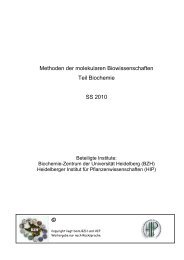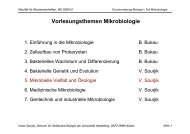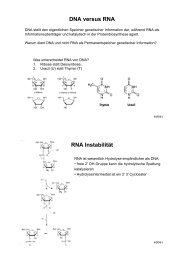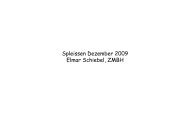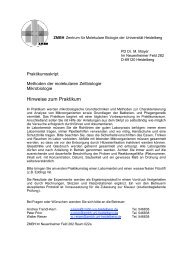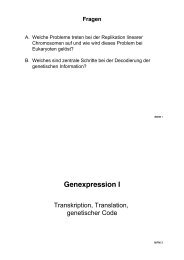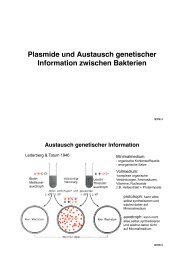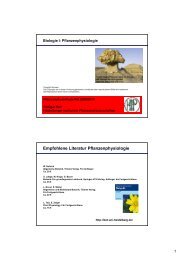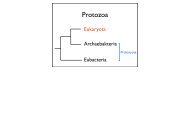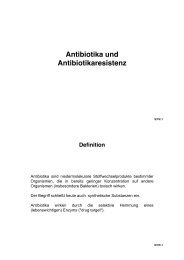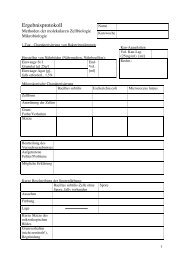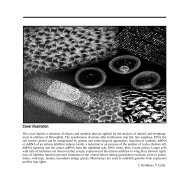ZMBH J.Bericht 2000 - Zentrum für Molekulare Biologie der ...
ZMBH J.Bericht 2000 - Zentrum für Molekulare Biologie der ...
ZMBH J.Bericht 2000 - Zentrum für Molekulare Biologie der ...
You also want an ePaper? Increase the reach of your titles
YUMPU automatically turns print PDFs into web optimized ePapers that Google loves.
Heinz Schaller<br />
Regulation of Hepatitis B Virus Replication<br />
Hepatitis B viruses (also hepadnaviruses, HBVs) are<br />
small, enveloped DNA viruses which cause acute and<br />
chronic liver infections in mammals and birds. Their<br />
prototype, the human HBV, is the causative agent of<br />
a world-wide major public health problem with about<br />
5 % of the world population being chronic HBV carriers<br />
and at high risk of developing liver cirrhosis and<br />
hepatocellular carcinoma. As ‘pararetroviruses’, these<br />
viruses are related to the retroviruses by genome organization<br />
and replication strategy, but differ in major<br />
features, e.g. by containing a DNA genome in the<br />
extra-cellular state, or by producing transcripts from<br />
a non-integrated, circular DNA template. The hepadnaviruses<br />
are characterized by a tissue tropism and<br />
a very narrow host range restricting them to their<br />
respective natural hosts and close relatives. These features<br />
have been an obstacle to the establishment of an<br />
HBV cell culture infection system, which is urgently<br />
needed for the development of targeted therapy.<br />
Despite these experimental difficulties with the HBV<br />
prototype, the hepadnavirus infection cycle has been<br />
worked out in consi<strong>der</strong>able detail from molecular<br />
analysis of HBV replication in cells transfected with<br />
cloned viral DNA, as well as from infection studies<br />
in the duck Hepatitis B virus (DHBV) animal system.<br />
The resulting replication model (Fig. 1) is well estab-<br />
Figure 1. The HBV replication cycle. Individual steps are indicated: (1,2) attachment to, and endocytosis into the host cell;<br />
(3,4) cytosolic release of the capsid and transport to the nucleus; (5) conversion of the viral genome into ccc-DNA, the<br />
template for transcription; (6) synthesis of genomic RNA, its maturation and transport to the cytoplasm, and (7) its translation<br />
into the core and polymerase gene products, followed by (8), coassembly into RNA-containing nucleocapsids, ((8‘)<br />
cyto-nucleoplasmic shuttling of core protein subunits, postulated to participate in genomic RNA maturation); (9) reverse<br />
transcription of the RNA genome into DNA, and (10) nucleocapsid maturation and export from the cell as enveloped virion.<br />
Alternatively, nucleocapsids import the mature DNA genome into the nucleus for replenishment of the ccc-DNA pool (11).<br />
For simplicity, synthesis and assembly of the envelope proteins from subgenomic RNA are omitted.<br />
116<br />
lished with respect to the basic mechanisms leading to<br />
the production of progeny virions (steps 7-10), but still<br />
uncertain as to the mechanisms and cellular components<br />
involved in determining receptor-mediated virus<br />
uptake (steps 2-4), and also as to those that control the<br />
establishment and persistence of productive infection<br />
(primarily steps 4, 6, and 11). These latter processes<br />
are difficult to study un<strong>der</strong> controlled conditions<br />
since no infectable cell lines exist even in case of<br />
the available animal models. Nevertheless, we have<br />
been increasingly focussing our research onto these<br />
research areas, as their better un<strong>der</strong>standing appears<br />
to be crucial for a rational approach towards our longterm<br />
goal, which is to establish an infection system for<br />
studying (and to interfere with) all steps of HBV replication<br />
cycle of the human virus in cultured cells, and<br />
in a small test animal.<br />
I. Parameters influencing the establishment<br />
and maintenance of hepadnavirus replication<br />
in primary hepatocyte cultures<br />
U. Klöcker, B. Zachmann-Brand, B. Glass, C.<br />
Kuhn, K. Rothmann, U. Protzer<br />
Hepatitis B viruses use a well-balanced replication<br />
strategy and an intimate cross talk with the host to<br />
establish productive, but non-cytotoxic, long-term persistent<br />
infections. As part of this strategy, virus replication<br />
and gene expression vary greatly in response<br />
to environmental changes of the state of the cell. For<br />
example, transfer of preinfected duck hepatocytes out<br />
of the tissue structure into cell culture results in an initial<br />
reduction of virus production followed by upregulation<br />
(Fig. 2). Furthermore, extracellular stimuli such<br />
as cytokines, the peptide hormone glucagon, or endotoxin<br />
from gram negative bacteria inhibit the establishment<br />
of DHBV replication in vitro. We have now<br />
shown that endotoxin acts indirectly by activating liver<br />
Figure 2. Changes in virus production from DHBV-infected<br />
primary duck hepatocytes in response to environmental<br />
changes. After plating, preformed virus is released, followed<br />
initially by decreased rates of production. From<br />
day 4 on, virus production increases, reaching constant<br />
levels around day 8. This process is inhibited by endotoxin-induced<br />
cytokines produced from liver macrophages<br />
(Klöcker et al., <strong>2000</strong>).<br />
macrophages to release cytokines which act at inhibitory<br />
an early step of DHBV replication (Fig. 2).<br />
Another example for cross talk with the host is our<br />
finding that the large envelope protein, although a<br />
structural protein, is varibly phosphorylated in cytosolic<br />
preS domains by ERK-type MAP kinases in<br />
response to to the state of the cell. In turn, changes in<br />
preS-phosphorylation correlated closely with the ability<br />
of DHBV L to activate gene expression in trans,<br />
in vitro and in vivo. Furthermore, a pathogenic phenotype<br />
with severe growth retardation and pathologic<br />
liver histology was observed in ducklings infected<br />
with a variant mimicking constitutive L phosphorylation.<br />
The above observations from experimental DHBV<br />
infection are complemented by data obtained with<br />
HBV-transgenic mice, which produce HBV from a<br />
chromosomally integrated HBV genome in titers comparable<br />
to chronically infected humans. In this system,<br />
117



